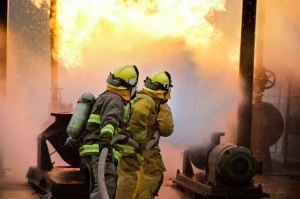 |
A study led by The National Institute for Occupational and Safety and Health (NIOSH), in collaboration with the National Cancer Institute and the Department of Public Health Sciences in the University of California at Davis, examined the relationship between firefighting and cancer. The findings, published online in the peer-reviewed journal Occupational & Environmental Medicine (OEM), reinforced a major fear among firefighters and their families:
Asbestos is a Hazard of Firefighting
Published on October 14, 2013, this new study examined mortality patterns and cancer incidence of a large group consisting of 29,993 U.S. career fighters employed since 1950 and followed through 2009. The results were astounding. Researchers found that the rate of mesothelioma for firefighters was two times greater than the rate of the U.S. population as a whole. This means, researchers found excess malignant mesothelioma in the population of firefighters in this study. Further, the findings “were associated with exposure to asbestos, a known cause of mesothelioma.”
While other cancer risk-factors such as smoking, diet, and alcohol consumption were not noted in the study’s conclusion, it is clear that the increased risk of malignant mesothelioma in firefighters was the result of asbestos exposure in buildings where this dangerous mineral has not been abated.
According to the Centers for Disease Control and Prevention (CDC), study findings also revealed that “cancers of the respiratory, digestive, and urinary systems accounted mostly for the higher rates of cancer seen in the study population. The higher rates suggest that firefighters are more likely to develop those cancers.” This is the result of exposure to several dangerous contaminants from fires including benzene and formaldehyde. Both contaminants are combustion by-products that are “known or suspected” to cause cancer, says the study.
Phase II of the NIOSH study is underway. In this Phase, the CDC says researchers will further examine employment records from the three fire departments involved in the study (Chicago, San Francisco, and Philadelphia), to derive information on occupational exposures. Researchers will examine exposures in relation to cancer incidence and mortality, says the CDC. Upon completion of the study, the CDC will present another article about the findings.
The NIOSH study, titled “Mortality and cancer incidence in a pooled cohort of US firefighters from San Francisco, Chicago and Philadelphia (1950–2009),” is supported in part by funding from the U.S. Fire Administration.
If you are a firefighter (or former firefighter) and you think you may have been exposed to asbestos, contact a doctor immediately for evaluation and testing. Symptoms of mesothelioma include (but are not limited to) bloating and pain, cough, chest pain (especially when taking a deep breath), shortness of breath, fatigue, and/or weight loss. Even if you are not experiencing symptoms, it’s never a bad idea to see a doctor on a regular basis for check-ups. When caught in its early stages, the chances of surviving mesothelioma greatly increase.
Download MRHFM’s infographic to learn more about mesothelioma.
If you have been diagnosed with mesothelioma, contact an attorney here at MRHFM to find out about your rights and the role MRHFM will play in protecting them. MRHFM is the largest firm exclusively devoted to helping mesothelioma victims and their families.
Sources
Centers for Disease Control and Prevention (CDC)
CDC
National Institute for Occupational Safety and Health (NIOSH)
NIOSH
Occupational & Environmental Medicine (OEM)
OEM


No comments yet. You should be kind and add one!
By submitting a comment you grant Mesothelioma Blog – Information, Research, News, Answers, Legal a perpetual license to reproduce your words and name/web site in attribution. Inappropriate and irrelevant comments will be removed at an admin’s discretion. Your email is used for verification purposes only, it will never be shared.